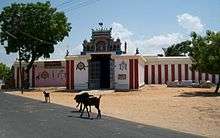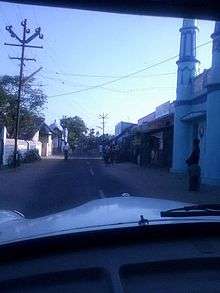Kulasekharapatnam
Kulasekarapatnam (Kulasekharapattinam), is a town in the Thoothukudi district (formerly Tinnelvelly or Tirunelveli) of Tamil Nadu, India.
Kulasekarapatnam Kulasekarapatnam , Kulasekarapattinam | |
|---|---|
Town | |
 Kulasekarapatnam Location in Tamil Nadu, India  Kulasekarapatnam Kulasekarapatnam (India) | |
| Coordinates: 8°24′0″N 78°3′0″E | |
| Country | |
| State | Tamil Nadu |
| District | Thoothukudi |
| Government | |
| • Body | Kulasekarapatnam Panchayat |
| Area | |
| • Total | 12.5 km2 (4.8 sq mi) |
| Population (2001) | |
| • Total | 12,010 |
| • Density | 960/km2 (2,500/sq mi) |
| Languages | |
| • Official | Tamil |
| Time zone | UTC+5:30 (IST) |
| PIN | 628206 |
| Telephone code | 4639 |
| Vehicle registration | TN 69 |
| Nearest city | Thoothukudi |
| Sex ratio | 1000:1177 ♂/♀ |
| Literacy | 85.91% |
| Lok Sabha constituency | Thoothukudi Formerly with Tiruchendur |
| Vidhan Sabha constituency | Tiruchendur |
| Civic agency | Kulasekarapatnam Panchayat Board |
| Climate | Humid (Köppen) |
| Website | www |
Kulasekharapatnam was an ancient port dating to the 1st centuries AD and was contemporaneous to the existence of Kollam, Cheran Port, another Pandyan port. Kollam served the Pandyas on the west coast while Kulasekharapatnam served them on the east coast connecting them to Ceylon and the pearl fisheries in the Gulf of Mannar facing the Tirunelveli Coast. The other ports on the Coromandel Coast were Kaveripumpattinam (Poompuhar) and Arikamedu (near Pondicherry). On the west coast the ancient ports were Kodungallur and Barugachha (Broach) in Gujarat.[1] Kulasekharapatnam lost its significance once Tuticorin became a big port.[2]
Kulasekharapatnam the name is derived from pandyan ruler Maravarman Kulasekara Pandyan I. Kulasekharapatnam is referred to in Marco Polo's travel diaries dating to 1250 AD.
Kulasekharapatnam has Muslim settlements since ancient times.
The famous Mutharamman Temple, which is 300 years old, is located in this place. Also, at the north of this village, an ancient marvelous Temple Dharmasvardhni has situated.
Sugar factory was running very successfully till the end of the British rule. Since the British rule Kulasekharapatnam has customs office. British Railway Line was established and it was called Kulasekharapatnam Light Railway and the stations were Kulasekharapatnam Central, Kulasekharapatnam Port and KPM Sugar factory in 1933.
ISRO has announced that a new space launch pad will be setup at Kulasekharapatnam [3]
Old Harbour mentioned by Marco Polo
Marco Polo describes the Pandyan port city of Kulasekharapatnam which even now we can see in the seashore of Kulasekharapatnam that Some Pillars which were used to give the right direction for ships as it is at this city that all the ships touch that come from the west, as from Hormos and from Kis and from Aden, and all Arabia, laden with horses and with other things for sale. And this brings a great concourse of people from the country round about, and so there is great business done in this city.
Marakkars & Rowthar Settlement
Now Kulasekarapatnam has Muslim Population as Marakkars or Marakkayars they were doing trade with Ships, they had come from Kerala, it is said Kunjali Marakkar's family members coming from kerala. In Kulsekarapatnam till 1965 the small ships "Dhoni" operated from there. If one town was a port, it must have had a Light House. Kulasekharapatnam even now has a light house in near Manapad. In Kulasekharapatnam, now even called a part of this town Rawthar Paalyam that Rawthar is called to a section of Muslim that their trade with horses. kulasekharapatnam was also an important trade centre even before the arrival of Islam. Since the 8th century AD, This city is inhabited by Muslims belonging to the Indian race.

History of Origin of Marakkars
Maraicar or Maraicayar, Marakayar, Maraicar is a distinctive Tamil and Malayalam-speaking Muslim people of the states of Tamil Nadu and Kerala in India. The name Marakkar is different from Marakkayar (Marikkar & Maricar are other spellings used in history books). According to many other historians, Moppila or Moplah is Maha Pillai (great son) and Marakkar means (Marakkalam is a wooden boat) ‘boatmen’. Thurston in his Tribes of S India, states the following - The word Marakkar is usually derived from the Arabic ‘Markab’, a boat. The story goes that, when the first immigrants of this class (they were apparently driven from their own country by persecutions) landed on the Indian shores, they were naturally asked who they were, and where they came from. In answer they pointed to their boats, and pronounced the word Markab, and they became in consequence Marakkars, or the people of Markab.[4]
Was it also a titular name for seaborne traders? KVK Iyer clarifies in his history of Kerala that Marakkar was a prized title given by the Zamorin of Calicut. Derived from Marakka Rayar it signifies the captain of a ship Rayar (Captain) of Marakkalam (ship)[4]
Traditionally, the Maricars engaged in mercantile commerce. They can be found along coastal areas of the states of Kerala and Tamil Nadu in India. They are generally considered to be of Middle Eastern(Arab) origin.[4]
Most of us have heard and read about the famous Kunhali Marakkar and his exploits, but one question remains, where did they come from? There have been many questions about their real origins, were they Moplahs of Arab extract from Pantalayani Kollam (South of Calicut); were they of Sri Lankan origin, were they Tamil Marakkars or were they from Tulunad? The research was quite interesting and the result obtained cannot be termed fully conclusive but was quite revealing. For those here, and only interested in Kunjali’s story, this does not cover the life and times of any of the famous Kunhali’s but hovers only around theories of their possible origin.[4]
The Maraicars can be found in coastal areas of South India, including Kerala and Tamil Nadu.
Around the 12th century AD in Arab countries there was a dispute among two kings who belongs to the same royal family which later erupted in war. The defeated members of the royal family were packed in ships and banished with their captains and servants. Those who settled in coastal regions of India [Tamil Nadu and Kerala] are called marakala rayars, [MARAKALAM which means wooden boat and RAYAR which means king in the Tamil language]. The captains of the ships are called malimars (malumiyar comes from the Tamil word MALUMI and YAR, malumi means captain in Tamil) and the ship crew members are called sherangs. Even today malimars [malumiyars], sherangs and Maricars [Marakalrayars] are to be found living only on the coast of Tamil Nadu. Maricars can be found abundance in Maraikayar Pattinam (which is thought to be the ancestral hometown of the early Maricars), Parangipettai (Portonovo), Kulasekharapatnam, Karaikal, Kilakarai, Adirampattinam, Muthupet, Nagore, Nagapattinam, Manjakollai and various other coastal towns.[4]

References
- K. A. Nilakanta Sastri, History of South India, 2nd ed.,Oxford University Press, 1958
- "Picnic on the beach". The Hindu. Chennai, India. 15 October 2005.
- "New launch pad in Tamil Nadu to help Isro". Times of India. Retrieved 28 June 2020.
- "Search Results Web results The Marakkar's and their origins".
|first=missing|last=(help)
External links
| Wikimedia Commons has media related to Kulasekharapatnam. |
- https://web.archive.org/web/20111015080841/http://indianmuslims.in/kunjali-marakkar/
- Kudi Maraikayar of eastern Sri Lanka
- Muslim Identity, Print Culture, and the Dravidian Factor in Tamil Nadu - J. B. Prashant More
- Medieval Seafarers of India - Lakshmi Subramaniam
- India & the Indian Ocean world – Ashin Das Gupta
- Moors of Sri Lanka
- Political Evolution of Muslims in Tamil Nadu and Madras - J. B. Prashant More
- Kerala Muslim History – PA Syed Mohammed
- Tuhfat Al Mujahideen – Zainuddin Makhdum
- Charithrathile Marakkar Sannidhyam – SV Mohammed
- Kunjali Marakkar – Kerala Calling Malabar & the Portuguese – KM Panikkar
- Castes & tribes of S India – Thurston
- Portuguese Cochin & the Maritime trade of India – Pius Malekandathil
- The Career and Legend of Vasco Da Gama - Sanjay Subrahmanyam
- Paramasivan kannan